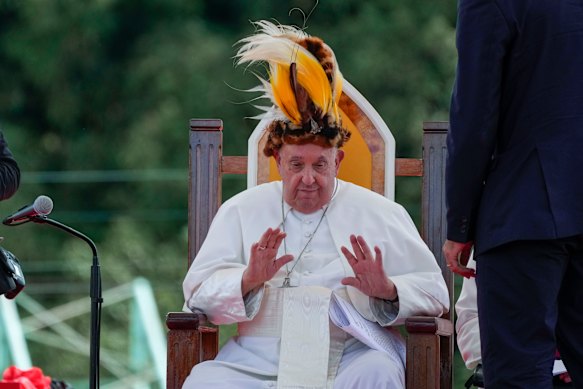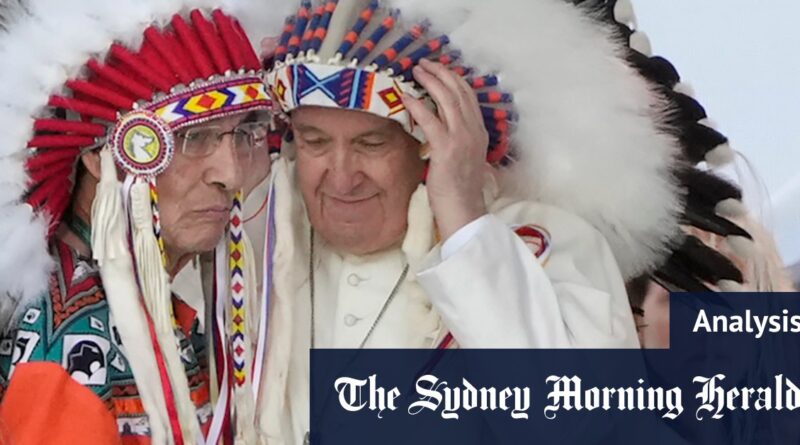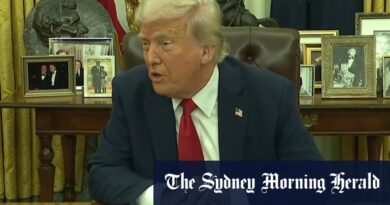Well-travelled Pope never made it to Australia – or to his home country
His international journeys could never equal those of Pope John Paul II, one of the most travelled leaders in world history. In his 26.5 years as pope, John Paul II visited 129 countries – several repeatedly – on 104 trips. He visited Australia twice: for a multi-city tour in late 1986, and in January 1995 when he travelled to Sydney for the beatification of Mary McKillop.
Pope Benedict XVI visited Sydney in July 2008 for World Youth Day, delivering mass to a crowd of more than 400,000 people at Randwick Racecourse.

Pope Francis receives a traditional hat during a meeting with faithful in Vanimo, Papua New Guinea, in September 2024.Credit: AP
The closest Francis came to Australia was last September when, aged 87, he travelled to Timor-Leste, where the population is estimated to be 97 per cent Catholic, and to Papua New Guinea.
The 12-day trip – the longest the Pontiff had spent away from the Vatican – also took him to Indonesia and Singapore.
Despite efforts by Australia’s Catholic leaders to push for a brief papal visit, possibly to Darwin, Francis’ faltering health was given as the reason for not including Australia in his gruelling itinerary.
Parts of his papacy overlapped with Australia’s Royal Commission into Institutional Responses to Child Sexual Abuse, which heard historical evidence against Cardinal George Pell, whom Francis had appointed to oversee the Vatican’s finances. Pell was convicted, jailed, then cleared by the Australian High Court, but the issue of the Church’s response to clerical abuse remained in Australian minds.

Cardinal George Pell had a close relationship with the Pope. The pair shared a private audience in 2020 when Pell returned to Rome after his acquittal over sex abuse allegations.Credit: Vatican News/AP
Anti-Pell protesters clashed with the faithful during the cardinal’s funeral in Sydney in 2023.
However, Francis did not shy away from confronting the issue of child abuse while visiting Canada in 2022, when he apologised for the historical abuse of Indigenous children in Catholic-run schools. “I humbly beg forgiveness for the evil committed by so many Christians against the indigenous peoples,” he said.
There were more notable absences than Australia from the Pope’s world travels, including that of his own home country.
As pope, he never visited Argentina, the country of his birth, where he became archbishop of Buenos Aires in 1998 before being made a cardinal in 2001.
During Argentina’s election campaign in 2023, the now president, the Trump-style Javier Milei, called Francis an “imbecile” for pursuing social justice and the “son of a bitch who preaches communism”.
The pontiff later indicated he’d forgiven Milei and said he was planning to travel home late last year, adding that he worried about his country because “its people are suffering so much”.
In the end, Francis’ health problems defeated his hope of a home-country visit.
He never made it to China, either, despite professing a wish to do so.

Pope Francis interacts with young people in Jakarta in Muslim-majority Indonesia in September 2024.Credit: AP
His trip last year – particularly to Singapore, where the population is only 19 per cent Christian but which strongly supports China’s engagement in the region – was seen partly as an extension of Francis’ desire to further improve relations between the Vatican and China.
The delicate relationship had progressively warmed since 2018, when a series of agreements granted about 10 Chinese bishops recognition both within China and by the pope.
Flying home after leaving Singapore, Francis told journalists that “China, for me, is a dream, that is to say that I would like to visit China”.
Loading
Many of his previous trips were to relatively poor countries in Africa, to politically troubled nations in South America, and to eastern European countries emerging since the Cold War.
Among his first visits were to Jordan, Israel and Palestine in 2014, when he engaged with Muslims, Jews and the Eastern Orthodox Church.
Francis’s commitment to social justice, which was often reflected in his choice of destination and for the messages he delivered in defence of the poor and of immigrants, could be traced back to his time as a priest and archbishop in Argentina.
There, he became known as a “villero priest” (slum priest) for working among the most impoverished inhabitants of shanty towns. As archbishop, he doubled the number of priests in the slums.
He was the first pope to take the name Francis. It was in honour of St Francis of Assisi, a lover of the poor.

Pope Francis, left, speaks to migrants, wearing white caps, during his visit to the island of Lampedusa, southern Italy, to show solidarity with migrants.Credit: AP
He was also more than capable of taking part in world affairs at the highest level.
As the first Latin American pope, Francis was considered a key architect of the reopening of diplomatic relations between the US and Cuba in July 2015.
Two months later, he visited both Cuba and the US, a symbolic link between the two countries, previously disconnected for 70 years.
Loading
He met president Barack Obama at the White House and became the first pontiff to address a joint session of the United States Congress.
Francis was not a supporter of US President Donald Trump’s policies and never travelled to the US to meet him.
Instead, Trump and his family went to the Vatican in 2017 to meet the Pope for a short discussion behind closed doors. Photos showed a beaming Trump and a glum Francis.
Soon after Trump returned to the Oval Office this year, Francis – who had earlier described Trump’s plan to deport millions of migrants as “a disgrace” – wrote an open letter to America’s Catholic bishops, saying criminalising migrants and taking measures built on force “will end badly”.
“I exhort all the faithful of the Catholic Church … not to give in to narratives that discriminate against and cause unnecessary suffering to our migrant and refugee brothers and sisters,” he said.
It seems unlikely that Francis, had he lived, would have travelled to Washington any time soon.
Get a note directly from our foreign correspondents on what’s making headlines around the world. Sign up for the weekly What in the World newsletter here.





